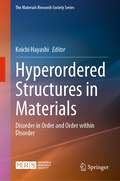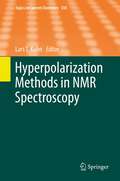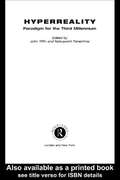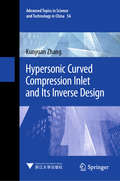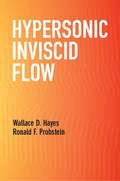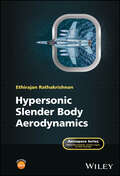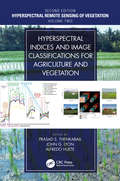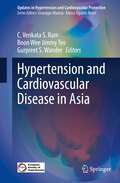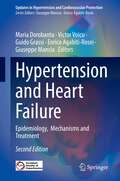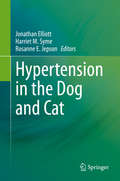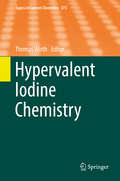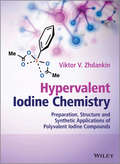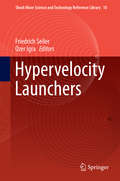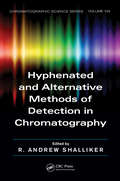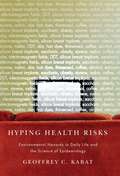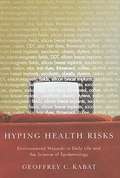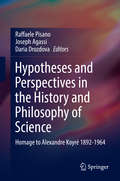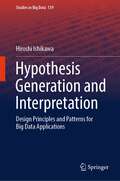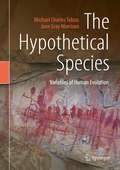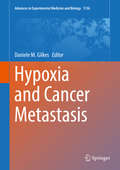- Table View
- List View
Hyperordered Structures in Materials: Disorder in Order and Order within Disorder (The Materials Research Society Series)
by Koichi HayashiThis book introduces characterizations of hyperordered structures using latest quantum beam technologies, the advanced theoretical methods for understanding the roles of the structures, and the state-of-the-arts materials containing the structures. In this book, the authors focus on the importance of defect complexes to improve functionality of crystals and that of orders of network structures to improve functionality of glass materials. These features can be regarded as interphases between perfect crystals and perfect amorphous, and they are the key factor for the evolution of materials science to a new dimension. The authors call such interphases "hyperordered structures" in this book. This is the first book that comprehensively summarizes glass science, defect science, and quantum beam science. It is valuable not only for active researchers in industry and academia but also graduate students.
Hyperpolarization Methods in NMR Spectroscopy
by Lars T. KuhnElucidating Organic Reaction Mechanisms using photo-CIDNP Spectroscopy, by Martin Goez. Parahydrogen Induced Polarization by Homogeneous Catalysis: Theory and Applications, by Kerstin Münnemann et al. Improving NMR and MRI Sensitivity with Parahydrogen, by R. Mewis & Simon Duckett. The Solid-state Photo-CIDNP Effect, by Jörg Matysik et al. Parahydrogen-induced Polarization in Heterogeneous Catalytic Processes, by Igor Koptyug et al. Dynamic Nuclear Polarization Enhanced NMR Spectroscopy, by U. Akbey & H. Oschkinat. Photo-CIDNP NMR Spectroscopy of Amino Acids and Proteins, by Lars T. Kuhn.
HyperReality: Paradigm for the Third Millenium
by John Tiffin Nobuyoshi Terashima'HyperReality is a technological capability like nanotechnology, human cloning and artificial intelligence. Like them, it does not as yet exist in the sense of being clearly demonstrable and publicly available. Like them, it is maturing in laboratories where the question "if" has been replaced by the question "when?" and like them, the implications of its appearance as a basic infrastructure technology are profound and merit careful consideration.' - Nobuyoshi TerashimaWhat comes after the Internet? Imagine a world where it is difficult to tell if the person standing next to you is real or a virtual reality, and whether they have human intelligence or artificial intelligence; a world where people can appear to be anything they want to be. HyperReality makes this possible.HyperReality offers a window into the world of the future, an interface between the natural and artificial. Nobuyoshi Terashima led the team that developed the prototype for HyperReality at Japan's ATT laboratories. John Tiffin studied they way HyperReality would create a new communications paradigm. Together with a stellar list of contributors from around the globe who are engaged in researching different aspects of HyperReality, they offer the first account of this extraordinary technology and its implications.This fascinating book explores the defining features of HyperReality: what it is, how it works and how it could become to the information society what mass media was to the industrial society. It describes ongoing research into areas such as the design of virtual worlds and virtual humans, and the role of intelligent agents. It looks at applications and ways in which HyperReality may impact on fields such as translation, medicine, education, entertainment and leisure. What are its implications for lifestyles and work, for women and the elderly: Will we grow to prefer the virtual worlds we create to the physical world we adapt to?HyperReality at the beginning of the third millennium is like steam power at the beginning of the nineteenth century and radio at the start of the twentieth century, an idea that has been shown to work but has yet to be applied. This book is for anyone concerned about the future and the effects of technology on our lives.
Hypersonic and High-Temperature Gas Dynamics
by John D. AndersonHypersonic and High-Temperature Gas Dynamics, Third Edition is a successful, self-contained text for those interested in learning hypersonic flow and high-temperature gas dynamics. Like previous editions, it assumes no prior familiarity with either subject on the part of the reader. It provides a cohesive presentation of the fundamentals, a development of important theory and techniques, a discussion of the salient results with emphasis on the physical aspects, and a presentation of modern thinking in these areas. This book is designed for two roles: As an effective classroom text that can be used with ease by the instructor, and understood with ease by the student As a viable, professional working tool for engineers, scientists, and managers who have any contact in their jobs with hypersonic and/or high-temperature flow This third edition has been updated throughout and features new figures and examples, along with a user-friendly interior design.
Hypersonic Curved Compression Inlet and Its Inverse Design (Advanced Topics in Science and Technology in China #56)
by Kunyuan ZhangThis book presents systematic research results on curved shock wave-curved compression surface applied to the compression surface design of supersonic–hypersonic inlet, which is a brand new inlet design. The concept of supersonic inlet curved compression discussed originated from the author’s research at the Deutsches Zentrum fur Luft- und Raumfahrt (DLR SM-ES) in the early 1990s. This book introduces the research history, working characteristics, performance calculation and aerodynamic configuration design method of this compression mode in detail. It also describes method of estimating the minimum drag in inlet and drag reduction effect of curved compression and proposes a new index for evaluating unit area compression efficiency of the inlet. Further, it reviews the relevant recent research on curved compression. As such it is a valuable resource for students, researchers and scientists in the fields of hypersonic propulsion and aeronautics.
Hypersonic Inviscid Flow
by Ronald F. Probstein Wallace D. HayesThis treatment of the branch of fluid mechanics known as hypersonic inviscid flow offers a self-contained, unified view of nonequilibrium effects, body geometries, and similitudes available in hypersonic flow and thin shock layer theory. Seeking to cultivate readers' appreciation of theory, the text avoids empirical approaches and focuses on basic theory and related fundamental concepts.Contents include introductory materials and chapters on small-disturbance theory, Newtonian theory, constant-density solutions, the theory of thin shock layers, numerical methods for blunt-body flows, and other methods for locally supersonic flows.Geared toward the needs of students and researchers in the field of modern gas dynamics and those of hypersonic aerodynamics, this text is appropriate for graduate-level courses in hyspersonic flow theory as well as courses dealing with compressible flow.
Hypersonic Missile Nonproliferation: Hindering the Spread of a New Class of Weapons
by Richard H. Speier George Nacouzi Carrie Lee Richard M. MooreThis report examines the implications of the proliferation of hypersonic missiles and possible measures to hinder it. This report first explores some of the potential strategic implications of the proliferation of hypersonic missile technology beyond the three major powers, the United States, Russia, and China. It then examines the process of such proliferation. And finally, it discusses possible means for hindering such proliferation.
Hypersonic Slender Body Aerodynamics (Aerospace Series)
by Ethirajan RathakrishnanOne-of-a-kind resource on theoretical and application aspects of hypersonic slender body aerodynamics with many didactic features included throughout Developed using class-tested course material, Hypersonic Slender Body Aerodynamics presents the theoretical and application aspects of the subject in a precise, concise, and student-friendly manner. The text includes a large number of worked examples, figures, diagrams, tables, and exercise problems. This book covers the subject material beginning from the definition of the slender body geometry through to the study of flow field around the body and the calculation of the aerodynamic and thermal loads acting on the body at speeds ranging from low to high (i.e., from incompressible to hypersonic speeds). The Mach number independence principle and approximate theories for caret wings are also covered, among many other key topics. This book is unique in its comprehensive coverage of the topic, enabling readers to find information in one place instead of scattered throughout proprietary wind tunnel test data, flight test data, government technical reports, scientific literature sources, and numerical methods. Some of the concepts explored in Hypersonic Slender Body Aerodynamics include: Wings of supersonic aircraft, covering sharp leading edges and ground and viscous effects, and pressure distribution on surfaces, covering transverse and longitudinal flow Hypersonic aerodynamics, covering atmospheric properties, hypersonic-flow characteristics, governing equations, and flow past a semi-wedge Application of slender-body theory, covering leading-edge heat transfer, sublimation, aerodynamic effects, nose bluntness, blast-wave theory, and thin shock layers Axisymmetric slender bodies, covering potential flow solutions and pressure distribution, and drag of slender bodies, covering shape factor and blunt after-body corrections Skillfully written with a clear and engaging writing style, Hypersonic Slender Body Aerodynamics is an essential learning resource on the subject for undergraduate and graduate students of aerospace engineering and practicing engineers working in aerospace research labs and industries. It is a perfect textbook for courses on slender body aerodynamics.
Hyperspace: A Scientific Odyssey Through Parallel Universes, Time Warps, and the Tenth Dimension
by Michio KakuAre there other dimensions beyond our own? Is time travel possible? Can we change the past? Are there gateways to parallel universes? All of us have pondered such questions, but there was a time when scientists dismissed these notions as outlandish speculations. Not any more. Today, they are the focus of the most intense scientific activity in recent memory. In Hyperspace, Michio Kaku offers the first book-length tour of the most exciting (and perhaps most bizarre) work in modern physics. <p><p>The theory of hyperspace (or higher dimensional space)—and its newest wrinkle, superstring theory—stand at the center of this revolution, with adherents in every major research laboratory in the world. Beginning where Hawking's Brief History of Time left off, Kaku paints a vivid portrayal of the breakthroughs now rocking the physics establishment. Why all the excitement? As the author points out, for over half a century, scientists have puzzled over why the basic forces of the cosmos—gravity, electromagnetism, and the strong and weak nuclear forces—require markedly different mathematical descriptions. But if we see these forces as vibrations in a higher dimensional space, their field equations suddenly fit together like pieces in a jigsaw puzzle, perfectly snug, in an elegant, astonishingly simple form. This may thus be our leading candidate for the Theory of Everything.
Hyperspectral Imaging Remote Sensing: Physics, Sensors, and Algorithms
by Dimitris G. Manolakis Ronald B. Lockwood Thomas W. CooleyA practical and self-contained guide to the principles, techniques, models and tools of imaging spectroscopy. Bringing together material from essential physics and digital signal processing, it covers key topics such as sensor design and calibration, atmospheric inversion and model techniques, and processing and exploitation algorithms. Readers will learn how to apply the main algorithms to practical problems, how to choose the best algorithm for a particular application, and how to process and interpret hyperspectral imaging data. A wealth of additional materials accompany the book online, including example projects and data for students, and problem solutions and viewgraphs for instructors. This is an essential text for senior undergraduate and graduate students looking to learn the fundamentals of imaging spectroscopy, and an invaluable reference for scientists and engineers working in the field. A self-contained introductory text covering the principles, techniques, and tools of imaging spectroscopy. Can be used in both undergraduate and graduate settings, and also as a reference text for practitioners. Accompanied online by example projects and data for students, and problem solutions and viewgraphs for instructors.
Hyperspectral Indices and Image Classifications for Agriculture and Vegetation (Hyperspectral Remote Sensing of Vegetation, Second Edition)
by Prasad S. Thenkabail, John G. Lyon and Alfredo HueteWritten by leading global experts, including pioneers in the field, the four-volume set on Hyperspectral Remote Sensing of Vegetation, Second Edition, reviews existing state-of- the-art knowledge, highlights advances made in different areas, and provides guidance for the appropriate use of hyperspectral data in the study and management of agricultural crops and natural vegetation.Volume II, Hyperspectral Indices and Image Classifications for Agriculture and Vegetation evaluates the performance of hyperspectral narrowband or imaging spectroscopy data with specific emphasis on the uses and applications of hyperspectral narrowband vegetation indices in characterizing, modeling, mapping, and monitoring agricultural crops and vegetation. This volume presents and discusses topics such as the non-invasive quantification of foliar pigments, leaf nitrogen concentration of cereal crop, the estimation of nitrogen content in crops and pastures, and forest leaf chlorophyll content, among others. The concluding chapter provides readers with useful guidance on the highlights and essence of Volume II through the editors’ perspective.Key Features of Volume II: Provides the fundamentals of hyperspectral narrowband vegetation indices and hyperspectral derivative vegetation indices and their applications in agriculture and vegetation studies. Discusses the latest advances in hyperspectral image classification methods and their applications. Explains the massively big hyperspectral sensing data processing on cloud computing architectures. Highlights the state-of-the-art methods in the field of hyperspectral narrowband vegetation indices for monitoring agriculture, vegetation, and their properties such as plant water content, nitrogen, chlorophyll, and others at leaf, canopy, field, and landscape scales. Includes best global expertise on hyperspectral remote sensing of agriculture, crop water use, plant species detection, crop productivity and water productivity mapping, and modeling.
Hyperspherical Harmonics Expansion Techniques
by Tapan Kumar DasThe book provides a generalized theoretical technique for solving the fewbody Schrödinger equation. Straight forward approaches to solve it in terms of position vectors of constituent particles and using standard mathematical techniques become too cumbersome and inconvenient when the system contains more than two particles. The introduction of Jacobi vectors, hyperspherical variables and hyperspherical harmonics as an expansion basis is an elegant way to tackle systematically the problem of an increasing number of interacting particles. Analytic expressions for hyperspherical harmonics, appropriate symmetrisation of the wave function under exchange of identical particles and calculation of matrix elements of the interaction have been presented. Applications of this technique to various problems of physics have been discussed. In spite of straight forward generalization of the mathematical tools for increasing number of particles, the method becomes computationally difficult for more than a few particles. Hence various approximation methods have also been discussed. Chapters on the potential harmonics and its application to Bose-Einstein condensates (BEC) have been included to tackle dilute system of a large number of particles. A chapter on special numerical algorithms has also been provided. This monograph is a reference material for theoretical research in the few-body problems for research workers starting from advanced graduate level students to senior scientists.
Hypertension and Cardiovascular Disease in Asia (Updates in Hypertension and Cardiovascular Protection)
by C. Venkata S. Ram Boon Wee Jimmy Teo Gurpreet S. WanderThis book will cover all aspects of hypertension and the manifestations of cardiovascular disease in the Asian population. Asia has the largest population of all the continents, and also has the largest number of people suffering from these diseases. Due to an expanding economy and increasing affluent lifestyles, their incidence is increasing at alarming rates - in fact, this continent is a ticking time bomb for HTN and CVD outbreaks. The book fills a large gap, as there are currently no volumes on this topic - and provides much-needed information for physicians not only in Asia but globally. Not only physicians, but also all related medical professionals and libraries will benefit from this book, to which renowned international experts contributed.
Hypertension and Heart Failure: Epidemiology, Mechanisms and Treatment (Updates in Hypertension and Cardiovascular Protection)
by Maria Dorobantu Victor Voicu Guido Grassi Enrico Agabiti-Rosei Giuseppe ManciaThe second edition of this well-received book will offer both new insights into the intimate mechanisms of transition from hypertension to heart failure and clinical practice advice on the prevention and treatment of heart failure in hypertensive population. Heart failure is the result of the hypertension's effects on the heart and it is a growing public health problem, as it affects 20-50% of the adult population in developed countries. In this context the international scientific community is continuously struggling to develop better strategies in screening, diagnosing and treating hypertension and its deleterious effects. Thus, this field is continuously changing, with new important information being added constantly. A part of the book dedicated to diagnostics, comprising a chapter on new perspectives on multimodality imaging and a special chapter on diastolic dysfunction. The arrhythmic complications of hypertensive heart disease are discussed in two chapters on atrial fibrillation and ventricular arrhythmias respectively. Readers will also find new chapters regarding hypertension and heart failure in special populations such as cancer patients, young patients, pregnancy and patients with a history of SARS-CoV2 infection. This book is a useful tool for clinicians but also to the research community interested in heart failure and consequences of hypertension on heart who want to be up-to-date with the new developments in the field.
Hypertension in the Dog and Cat
by Jonathan Elliott Harriet M. Syme Rosanne E. JepsonThis book provides an in-depth review on various aspects of canine and feline hypertension. Physiology, pathophysiology, epidemiology and pathological consequences of high blood pressure in cats and dogs are discussed. A comparative approach is taken, the underpinning research is critically evaluated and knowledge gaps identified. In addition, the reader is presented with evidence-based treatment strategies. The book targets researchers, graduate students and clinical specialists in small animal internal medicine as well as veterinary clinicians with interest in nephrology, cardiology, neurology and ophthalmology.
Hypervalent Iodine Chemistry
by Thomas WirthThe series Topics in Current Chemistry presents critical reviews of the present and future trends in modern chemical research. The scope of coverage is all areas of chemical science including the interfaces with related disciplines such as biology, medicine and materials science. The goal of each thematic volume is to give the non-specialist reader, whether in academia or industry, a comprehensive insight into an area where new research is emerging which is of interest to a larger scientific audience. Each review within the volume critically surveys one aspect of that topic and places it within the context of the volume as a whole. The most significant developments of the last 5 to 10 years are presented using selected examples to illustrate the principles discussed. The coverage is not intended to be an exhaustive summary of the field or include large quantities of data, but should rather be conceptual, concentrating on the methodological thinking that will allow the non-specialist reader to understand the information presented. Contributions also offer an outlook on potential future developments in the field. Review articles for the individual volumes are invited by the volume editors. Readership: research chemists at universities or in industry, graduate students.
Hypervalent Iodine Chemistry
by Viktor V. ZhdankinHypervalent Iodine Chemistry is the first comprehensive text covering all of the main aspects of the chemistry of organic and inorganic polyvalent iodine compounds, including applications in chemical research, medicine, and industry.Providing a comprehensive overview of the preparation, properties, and synthetic applications of this important class of reagents, the text is presented in the following way: The introductory chapter provides a historical background and describes the general classification of iodine compounds, nomenclature, hypervalent bonding, structural features, and the principles of reactivity of polyvalent iodine compounds.Chapter 2 gives a detailed description of the preparative methods and structural features of all known classes of organic and inorganic derivatives of polyvalent iodine.Chapter 3, the key chapter of the book, deals with the many applications of hypervalent iodine reagents in organic synthesis.Chapter 4 describes the most recent achievements in hypervalent iodine catalysis.Chapter 5 deals with recyclable polymer-supported and nonpolymeric hypervalent iodine reagents.Chapter 6 covers the "green" reactions of hypervalent iodine reagents under solvent-free conditions or in aqueous solutions.The final chapter provides an overview of the important practical applications of polyvalent iodine compounds in medicine and industry.This book is aimed at all chemists interested in iodine compounds, including academic and industrial researchers in inorganic, organic, physical, medicinal, and biological chemistry. It will be particularly useful to synthetic organic and inorganic chemists, including graduate and advanced undergraduate students. It comprehensively covers the green chemistry aspects of hypervalent iodine chemistry, making it especially useful for industrial chemists.
Hypervelocity Launchers
by Friedrich Seiler Ozer IgraIn the present volume numerous descriptions of Ram accelerators are presented. These descriptions provide good overview on the progress made and the present state of the Ram accelerator technology worldwide. In addition, articles describing light gas gun, ballistic range including a chapter dealing with shock waves in solids are given. Along with the technical description of considered facilities, samples of obtained results are also included. Each chapter is written by an expert in the described topic providing a comprehensive description of the discussed phenomena.
Hyphenated and Alternative Methods of Detection in Chromatography (Chromatographic Science Ser.)
by R. Andrew ShallikerWidely employed for separating and detecting chemicals in solution, separation techniques are most often applied in tandem, subsequently referred to as hyphenated methods. Hyphenated and Alternative Methods of Detection in Chromatography details the development and application of mass spectral detection techniques coupled with gas phase and liquid
Hyping Health Risks: Environmental Hazards in Daily Life and the Science of Epidemiology
by Geoffrey KabatThe media constantly bombard us with news of health hazards lurking in our everyday lives, but many of these hazards turn out to have been greatly overblown. According to author and epidemiologist Geoffrey C. Kabat, this hyping of low-level environmental hazards leads to needless anxiety and confusion on the part of the public concerning which exposures have important effects on health and which are likely to have minimal or no effect. Kabat approaches health scares as "social facts" and shows that a variety of factors can contribute to the inflating of a hazard. These include skewed reporting by the media, but also, surprisingly, the actions of researchers who may emphasize certain findings while ignoring others; regulatory and health agencies eager to show their responsiveness to the health concerns of the public; and politicians and advocates with a stake in a particular outcome. By means of four case studies, Kabat demonstrates how a powerful confluence of interests can lead to overstating or distorting the scientific evidence. He considers the health risks of pollutants such as DDT as a cause of breast cancer, electromagnetic fields from power lines, radon within residences, and secondhand tobacco smoke. Tracing the trajectory of each of these hazards from its initial emergence to the present, Kabat shows how publication of more rigorous studies and critical assessments ultimately help put hazards in perspective.
Hyping Health Risks: Environmental Hazards in Daily Life and the Science of Epidemiology
by Geoffrey C. KabatAccording to author and epidemiologist Geoffrey C. Kabat, this hyping of low-level environmental hazards leads to needless anxiety and confusion on the part of the public as to which exposures have important effects on health.
Hypotheses and Perspectives in the History and Philosophy of Science
by Raffaele Pisano Joseph Agassi Daria DrozdovaTo commemorate the 50th anniversary of his passing (in 2014), this special book features studies on Alexandre Koyr#65533; (1892-1964), one of the most influential historians of science of the 20th century, who re-evaluated prevalent thinking on the history and philosophy of science. In particular, it explores Koyr#65533;'s intellectual matrix and heritage within interdisciplinary fields of historical, epistemological and philosophical scientific thought. Koyr#65533; is rightly noted as both a versatile historian on the birth and development of modern science and for his interest in philosophical questions on the nature of scientific knowledge. In the 1940s and 1950s his activities in the United States established a crucial bridge between the European historical tradition of science studies and the American academic environments, and an entire generation of historians of science grew up under his direct influence. The book brings together contributions from leading experts in the field, and offers much-needed insights into the subject from historical, nature of science, and philosophical perspectives. It provides an absorbing and revealing read for historians, philosophers and scientists alike.
Hypothesis Generation and Interpretation: Design Principles and Patterns for Big Data Applications (Studies in Big Data #139)
by Hiroshi IshikawaThis book focuses in detail on data science and data analysis and emphasizes the importance of data engineering and data management in the design of big data applications. The author uses patterns discovered in a collection of big data applications to provide design principles for hypothesis generation, integrating big data processing and management, machine learning and data mining techniques. The book proposes and explains innovative principles for interpreting hypotheses by integrating micro-explanations (those based on the explanation of analytical models and individual decisions within them) with macro-explanations (those based on applied processes and model generation). Practical case studies are used to demonstrate how hypothesis-generation and -interpretation technologies work. These are based on “social infrastructure” applications like in-bound tourism, disaster management, lunar and planetary exploration, and treatment of infectious diseases. The novel methods and technologies proposed in Hypothesis Generation and Interpretation are supported by the incorporation of historical perspectives on science and an emphasis on the origin and development of the ideas behind their design principles and patterns. Academic investigators and practitioners working on the further development and application of hypothesis generation and interpretation in big data computing, with backgrounds in data science and engineering, or the study of problem solving and scientific methods or who employ those ideas in fields like machine learning will find this book of considerable interest.
The Hypothetical Species: Variables of Human Evolution
by Michael Charles Tobias Jane Gray MorrisonThis book is a provocative and invigorating real-time exploration of the future of human evolution by two of the world’s leading interdisciplinary ecologists – Michael Charles Tobias and Jane Gray Morrison. Steeped in a rich multitude of the sciences and humanities, the book enshrines an elegant narrative that is highly empathetic, personal, scientifically wide-ranging and original. It focuses on the geo-positioning of the human Self and its corresponding species. The book's overarching viewpoints and poignant through-story examine and powerfully challenge concepts associated historically with assertions of human superiority over all other life forms. Ultimately, The Hypothetical Species: Variables of Human Evolution is a deeply considered treatise on the ecological and psychological state of humanity and her options – both within, and outside the rubrics of evolutionary research – for survival. This important work is beautifully presented with nearly 200 diverse illustrations, and is introduced with a foreword by famed paleobiologist, Dr. Melanie DeVore.
Hypoxia and Cancer Metastasis (Advances in Experimental Medicine and Biology #1136)
by Daniele M. GilkesThe present book is an attempt to provide a detailed review of studies that clarify our current understanding of the role of hypoxia in the progression of primary cancer to metastatic disease. It will enable researchers to discover the critical cellular changes that occur under hypoxic conditions and play a role in metastatic dissemination, from the activation of hypoxia-inducible factors, HIF-1 and HIF-2, to the transcriptional profile changes that occur in cancer cells and promote cancer cell survival under detrimental conditions. Readers will discover the methods and challenges involved in imaging and quantifying the degree of hypoxia in a primary tumor. We will provide an understanding of the hypoxia-induced phenotypes that influence heterogeneity, alter the secretome and tumor microenvironment, modify cellular metabolism, and promote immune suppression and resistance to chemotherapy. Finally, we will uncover the therapeutic strategies that are being devised to target the hypoxic microenvironment in the hopes of preventing metastasis and improving the efficacy of standard-of-care cancer treatments. This work is an up to date source of information on the challenges and complexity of the hypoxic tumor microenvironment. Basic and translational scientists, post-doctoral fellows, graduate students, and those interested in how tumors metastasize will find this book a reference that details how hypoxia influences metastatic disease.
